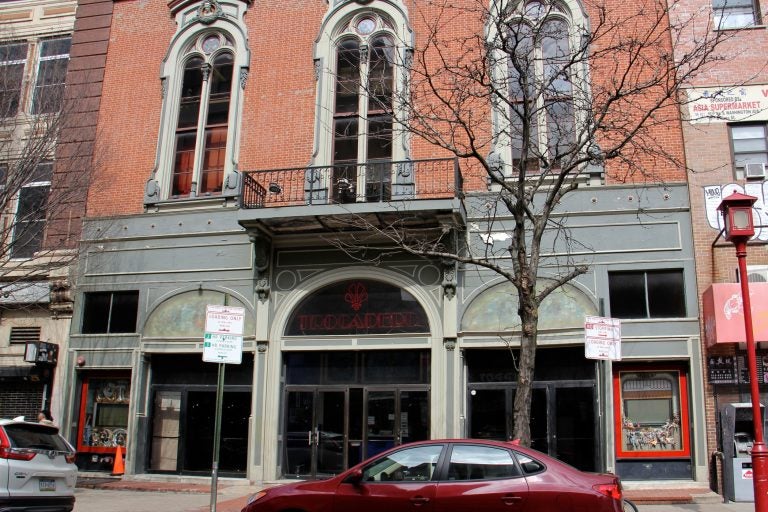Pagoda Palace Theater nearing its end
C.W. Nevius, Chronicle Columnist
Updated 9:04 am, Thursday, February 28, 2013

The Pagoda Palace Theater at Columbus Avenue and Powell Street in San Francisco's North Beach may finally have a date with the wrecking ball. Photo: Sarah Rice, Special To The Chronicle
There ought to be a plaque. If the Pagoda Palace Theater is finally torn down - and demolition could start as soon as April - something should mark the end of this colorful, contentious and incredibly frustrating chapter in San Francisco neighborhood lore.
The Pagoda began life in 1907 as a vaudeville theater and was transformed into a movie palace in the '20s with the advent of talkies. After that it was a little bit of everything, from a launch pad for a loopy, free-form flower-child performance troupe, to a showcase for campy kung fu movies, and finally, a potential neighborhood pharmacy. Incredibly, it was the latter that created so much controversy that it led to its most infamous role in North Beach.
Nothing.
For more than 20 years, in the vortex of the hottest, most expensive real estate in San Francisco, the Pagoda has stood vacant. Plans have come and gone, millions have been spent, but the only residents are pigeons, the only use is as a canvas for graffiti.
"It is a symbol of the complicated gestalt of North Beach," says Board of Supervisors President David Chiu, who represents the neighborhood.
In fairness, naysayers will point out that the location has been ready for development for years. Chiu says the final permissions were secured the day he came into office, Jan. 8, 2009. Unfortunately, that coincided with the nationwide economic downturn.
Finally, Chiu brokered the deal this year that changed the extraction of the Central Subway boring machines from the middle of Columbus Avenue - a horrible idea that would close North Beach's main street for weeks - to the Pagoda site. It gets the machines out, razes the old relic, and even clears the way for a potential North Beach subway stop.
It will increase the cost by some $9 million, but the city's Municipal Transportation Agency plans to pay that out of reserve funds and is confident it can replenish those funds, either with additional federal money or increased local revenue.
It has passed all the local hurdles, but still must pass scrutiny under the National Environmental Policy Act - and North Beach opponents are trying to use that process to stop the project. If they don't prevail, it looks as if the Pagoda, after closing in 1994, finally will disappear.
And let's be honest, not all the memories are bad. Take the days when it played kung fu films.
"I opened my first office in North Beach in 1982," said neighborhood activist and product designer Julie Christensen. "My first memory was that the Pagoda would broadcast whatever sound there was from the movie they were playing out in the street. So here, in this very Italian neighborhood, was this bubble of Chinese."
Ken Maley goes even further back, remembering the late '60s and '70s performances of the ****ettes, an extremely offbeat Summer of Love troupe.
"I would call it artistic chaos," Maley said. "The story line often changed - sometimes during the performance."
A check of online videos shows gauzy costumes, creative arm-waving, and plenty of sequins. The ****ettes became such a sensation that they were invited to New York. Unfortunately, they bombed and broke up soon afterward.
In many ways, the signature moment for the Pagoda came in 1997, when chain pharmacy Rite Aid proposed moving to the site. North Beach neighborhood organizations raised vociferous objections.
"A guy from Rite Aid shows up for a meeting," recalls longtime North Beach resident Richard Hanlin. "There must have been 500 people there and they pilloried the guy."
The Pagoda plan was shelved, which was a popular decision at the time. But as the years went on and neighborhood groups seemed opposed to any development, the plywood-covered Pagoda became a symptom of obstructionism. When a North Beach activist named Lynn Jefferson ran for supervisor, her motto was: "Enough with the plywood."
With an end in sight, some members of the North Beach community say they will raise a glass when the first jackhammer hits the Pagoda.
"I'm going sell tickets to the demolition," says Hanlin. "And then market the pieces for sale, like the Berlin Wall."




 Reply With Quote
Reply With Quote
 The place stank; if the rear doors were open you could hear the Pac-Man machines in the lobby. Once the front of the theater flooded, and as we watched the movies, it was reflected in the huge puddle covering the floor beneath the screen.
The place stank; if the rear doors were open you could hear the Pac-Man machines in the lobby. Once the front of the theater flooded, and as we watched the movies, it was reflected in the huge puddle covering the floor beneath the screen. 





